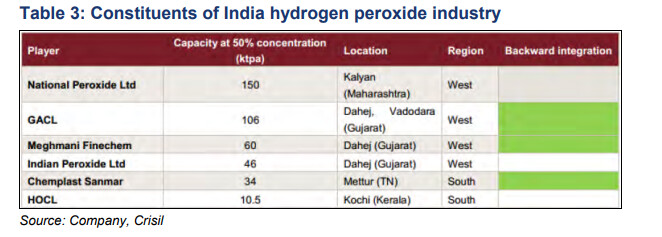Realization from Chlorine is expected to increase in the coming years as demand and capacity for PVC is expected to increase
Chlorine
There is a marked difference in the dynamics of chlorine in India compared with the global scenario. Globally, 38% of the chlorine produced is used by the vinyl industry, whereas it is only 8% in India in the absence of bulk demand from Vinyls. Consequently, the caustic-chlorine industry in India is mainly caustic driven unlike the rest of the world, where it is chlorine driven. In India, chlorine fetched negative realization at times due to its associated disposal costs which put pressure on the ECU realizations thereby making Indian caustic soda less competitive. During FY20, India produced 15.14 lakh MTPA of poly-vinyl chloride (PVC), while imports of the polymer were staggering at 19.16 lakh MT which was far above the domestic production thus making India the world’s largest importer. However, the scenario is expected to change now as India has announced the second-highest capacity addition of PVC at 17.4 lakh MTPA by 2025 after China. Hence, the challenge and costs associated with disposal of chlorine is expected to gradually subside going forward. From past three years, the realizations of chlorine have turned positive for domestic players and the trend is expected to continue even going forward which should support the ECU realization of the sector.
Structural change in Chor Alkali Industry highlighted in this report
Caustic-Chlorine_industry_in_India_-_12082021.pdf (292.3 KB)
Chloromethane
Chloromethane plant uses chlorine and methanol to produce three products: 1)methylene-dichloride (MDC, or dichloromethane), 2) chloroform, and 3) carbon tetrachloride (CTC). Company has put up the plant to utilise excess chlorine from its caustic soda facility.
India has six chloromethane producers: 1) GFL with capacity estimated at 108ktpa; 2) SRF with 100ktpa capacity, and another 100ktpa to be added in next few quarters; 3) GACL with 60ktpa capacity, which is being increased to 105ktpa; 4) Meghmani (45ktpa); 5) TGVSRAACL (41ktpa); and 6) CSL (35ktpa).
MDC has the highest demand among the three chloromethane products. The demand comes from pharmaceutical industry where it is used as a solvent. In small quantities, MDC is used as feedstock for ref-gas. In fact, increasing production of the new ref-gas HFO will expand demand for MDC. It is also used to produce foam and agrochemicals, but in very small quantities. India is deficit in MDC and 25-30% of it is imported; however, new capacity expansions should completely replace imports going
forward. Chloromethane demand has been growing ~9% CAGR in past 10 years with current market size seen at 500ktpa.
Chloroform is mainly used for manufacturing R-22 gas as well as in the pharmaceutical industry (as solvents), and adhesives and agrochemicals. The recent manufacturing technology allows chloromethane plants to produce slightly more MDC, and restrict production of chloroform.
CTC forms a very small portion of chloromethane production, and the new plants produce insignificant quantities of it. It is mainly used in the agrochemical insecticide cypermethrin and is finding increasing demand in the fluorospecialty segment.
Hydrogen Peroxide
India hydrogen peroxide demand at an estimated 320ktpa in FY20 and grew at a CAGR of 6.9% over FY15-FY20 led by growth in the paper & pulp segment, which forms 55% of the total India demand. Demand for hydrogen peroxide generally follows caustic soda as both derive significant demand from textiles and paper & pulp industries

GACL is placed better in the Industry due to backward and forward integration of Products . Further GACL usage of renewable energy is 25% of total energy required for the production which is cheaper than the fossil fuels.
| Subscribe To Our Free Newsletter |

